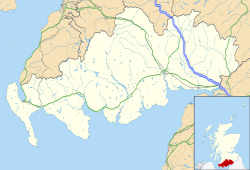| Kelloholm | |
|---|---|
 Aerial view | |
Location within Dumfries and Galloway | |
| OS grid reference | NS737116 |
| Council area | |
| Lieutenancy area | |
| Country | Scotland |
| Sovereign state | United Kingdom |
| Post town | SANQUHAR |
| Postcode district | DG4 |
| Dialling code | 01659 |
| Police | Scotland |
| Fire | Scottish |
| Ambulance | Scottish |
| UK Parliament | |
| Scottish Parliament | |
Kelloholm is a village in Dumfries and Galloway, Scotland. It has a primary school, [1] a public house and several shops. Kelloholm lies next to Kirkconnel and the two have begun to merge. Kelloholm was originally constructed to serve the many mines in the area, all of which have now closed.
